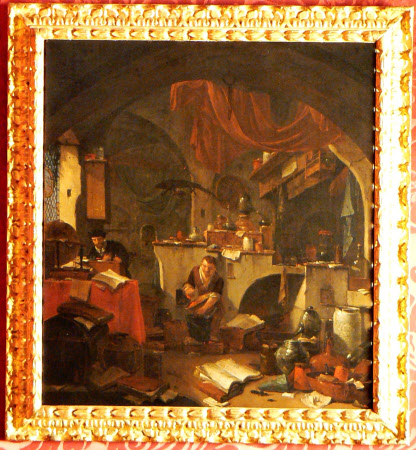An Alchemist
Thomas Wyck (Beverwijk 1616 - Haarlem 1677)
Category
Art / Oil paintings
Date
circa 1673
Materials
Oil on oak panel
Measurements
580 x 533 x 33 mm
Place of origin
England
Order this imageCollection
Ham House, Surrey
NT 1140060
Summary
Oil painting on oak panel, An Alchemist by Thomas Wyck (Beverwijk 1616 – Haarlem 1677), circa 1673. The alchemist is shown in his laboratory with an assistant. On the left, an alchemist writes while sitting at his desk near the window. In the centre, a roughly dressed assistant mixes something red in a bucket while perched on a stool. The high-ceilinged room is untidy, filled with books and alchemical equipment.
Full description
Paston held a laboratory at Paston Hall for which he employed an assistant, William. Paston’s letters present alchemy and ‘Chymistry’ to have both physical and mental components and the dual figures of alchemist and assistant represent both aspects in this painting. The painting also dualistically represents both a more realistic image of a contemporary laboratory, through its disorder due to objects littering the space, and an idealised depiction, through the presence of ‘red mercury’ in the assistant’s basin. 'Red mercury' was a large focus of Paston's alchemical investigations as on 6 June 1668, Thomas Henshaw lent an incomplete recipe for red mercury to Paston, which Paston copied down into what is now British Library Manuscript, Sloane 2222. Paston’s interest in alchemy, and 'red mercury' in particular, could have been motivated by potential profit as his family’s fortunes had been badly depleted supporting royalist causes. It is probable that the painting was hung near the workshop and could have served as an aspirational goal. By the 1703 inventory of Paston Hall, the painting was recorded to be located in the Servants’ Dining Room as “a picture of Chymistry by Old Wicke”. Thomas Wyck specialised in landscapes and genre scenes, often with Italian backdrops. He worked in England during the Restoration but moved back to the Dutch republic and was active in Haarlem before his death. This painting is typical of Thomas Wyck’s paintings of alchemists at work, of which at least a dozen survive.
Provenance
In 1679-83 catalogue and thence by descent until acquired in 1948 by HM Government when Sir Lyonel, 4th Bt (1854 – 1952) and Sir Cecil Tollemache, 5th Bt (1886 – 1969) presented Ham House to the National Trust, and entrusted to the care of the Victoria & Albert Museum, until 1990, when returned to the care of the National Trust, and to which ownership was transferred in 2002
Credit line
Ham House, The Dysart Collection (purchased by HM Government in 1948 and transferred to the National Trust in 2002)
Marks and inscriptions
signed - T Wijk
Makers and roles
Thomas Wyck (Beverwijk 1616 - Haarlem 1677), artist
References
Moore 2018: Andrew Moore, Nathan Flis and Francesca Vanke (eds.), The Paston Treasure: microcosm of the known world, (exh. cat.), New Haven: Yale Center for British Art; Norwich: Norfolk Museums Service; New Haven and London: Yale University Press, 2018., pp. 218-231, 410-411 (cat.116) Dickson 1997: Donald R. Dickson, ‘Thomas Henshaw and Sir Robert Paston’s Pursuit of the Red Elixir: An Early Collaboration between Fellows of the Royal Society’, Notes and Records of the Royal Society of London, 51: 1, Jan 1997, pp.57-76

